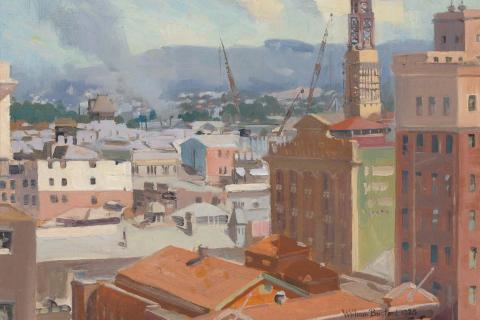Brisbane panorama
By Claire Gobé
February 2005
From the 1850s, a 'views trade' in mass-produced photographs of sights, events and people of significance thrived in Australia's major population centres. The trade expanded significantly in the 1890s due to the proliferation of amateur photography and an increase in tourism between the colonies. By around 1914, however, photographs had been superseded by illustrated magazines as the preferred source of popular imagery.
(Brisbane panorama) is an impressive photograph of Brisbane taken in 1910. The work features the City Botanic Gardens, viewed from Kangaroo Point across the Brisbane River. The two large ships moored in the foreground were the Dutch battleships the 'De Ruyter', to the right, and the 'Hertog Hendrik', to the left. These vessels arrived in Brisbane on 10 September 1910, before making their way down to Sydney and Melbourne later that month.1 Their visit was covered extensively by local press in each of these cities, and in Brisbane was featured in an article in The Brisbane Courier.2
Gelatin silver printing, the process used to create (Brisbane panorama), was developed in the 1870s, and became popular with amateur and professional photographers in Australia in the 1890s. The process required short exposure times and negatives could easily be enlarged, characteristics that were exploited to full advantage in the large-scale printing of this work. By 1910 gelatin silver printing was the favoured process for the production of black and white photographs in Australia.
The quality and clarity of (Brisbane panorama) implies that its unidentified photographer was highly trained and had access to professional equipment. According to the photographic historian Gael Newton, professional studios frequently printed a standard set of images for the views trade, often repeating those sold by their competitors.(3) In Brisbane these views tended to be elevated vistas of the city centre seen from north Brisbane, south Brisbane, and, as in (Brisbane panorama), from Kangaroo Point. Artists such as Conrad Martens also produced works with a similar orientation. The Gallery holds in its Collection Martens' pencil sketch of this view, Brisbane 1855, along with Kangaroo Point panorama, an albumen photograph from around 1880. The panorama was one of the most common formats used by both photographers and painters to capture picturesque vistas of the sprawling new city.
Essay by Claire Gobé, former Curatorial Assistant, Australian Art, QAGOMA.
Endnotes
- The two vessels travelled with a third ship, the 'Koningen Regentes', which was moored in a different area of the river during their stay in Brisbane ('ScreenSound Australia in Melbourne: Bayside bulletin: Bay video project bulletin no. 9', Dec. 2001, viewed 9 Sept. 2004).
- Rod McLeod, Honorary Research Officer at the Queensland Maritime Museum, email to Claire Gobé, 27 July 2004.
- Gael Newton, Shades of light, William Collins Pty Ltd, Sydney, in association with NGA, Canberra, 1988, p.83.
Connected objects

Brisbane 1855
- MARTENS, Conrad - Creator

(Brisbane panorama) 1910
- UNKNOWN - Creator

Kangaroo Point panorama c.1880
- UNKNOWN - Creator
Metadata, copyright and sharing information
About this story
- Subject
